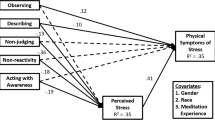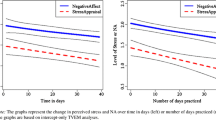This study examined the impact of perceived stress on responses to messages that encouraged the performance of health promotion and disease detection behaviors. It was hypothesized that increases in perceived stress would be associated with decreased processing of messages encouraging disease detection behaviors, and that increases in perceived stress would not effect the processing of messages encouraging health promotion behaviors. To test these hypotheses participants completed a perceived stress measure and then read a message that encouraged the performance of either a health promotion or a disease detection behavior. Then the participants were asked to indicate their agreement with the message and to attempt to recall the message. The results indicated that participants experiencing higher levels of perceived stress spent less time reading and recalled less of the messages about detection behaviors than of the messages about promotion behaviors. When participants were experiencing lower levels of perceived stress these differences disappeared.





Similar content being viewed by others
Notes
Two participants failed to complete the procedures and were not included in any of the statistical analyses.
When gender was applied as variable to each of the analyses it was not involved in any significant effects.
Aiken and West (1991) suggest that differences between the groups be examined at one SD above and below the mean. Although the predicted interaction between Behavior Type and Stress Level was obtained, there were not significant differences between the detection behavior group and promotion behavior groups at one SD above the mean. Only when more extreme scores were used (scores that were 1.5 SD below the mean) did the difference between the detection group and promotion group at low levels of stress disappear.
The reading time data in this study, like most response time measures, was skewed with some trials being very slow. All analyses of reading time data reported in this paper have been subjected to a logarithmic transformation (see Kirk (1986) and Smith and Lerner (1986) for discussions of response latency transformations).
REFERENCES
Aiken, L., and West, S. (1991). Multiple regression: Testing and interpretating interactions. Sage, Newbury Park, CA.
Ashby, W., Sandy, J., and Yaeger, A. (2002). Stress and smoking in adolescence: A test of directional hypothesis. Health Psychol. 21: 122–130.
Baron, R. M., and Kenny, D. (1986). The moderator-mediator variable distinction in social psychological research: Conceptual, strategic, and statistical considerations. J. Pers. Soc. Psychol. 51: 1173–1182.
Bentler, P. (1995). EQS Structural Equations Program Manual. Encino. Multivariate Software, CA.
Blumberg, S. (2000). Guarding against threatening HIV prevention messages: An information-processing model. Health Educ. Behav. 27: 780–795.
Cacioppo, J., and Petty, R. (1982). The need for cognition. J. Pers. Soc. Psychol. 42: 116–131.
Cacioppo, J., and Petty, R. (1989). Effects of message repetition on argument processing, recall, and persuasion. Basic Appl. Soc. Psychol. 10: 3–12.
Chaiken, S., and Maheswaran, D. (1994). Heuristic processing can bias systematic processing: Effects of source credibility, argument ambiguity, and task importance on attitude judgment. J. Pers. Soc. Psychol. 66: 460–473.
Chen, E., Lewn, M., and Craske, M. (1996). Effects of state anxiety on selective processing of threatening information. Cogn. Emot. 10: 225–240.
Cohen, S. (1988). Perceived stress in a probability sample of the United States. In Spacapan, S., and Oskamp, S. (Eds.), The social psychology of health. The Claremont Symposium on Applied Social Psychology. Sage, Thousand Oaks, CA, pp. 31–67.
Cohen, S., Kamarck, T., and Mermelstein, R. (1983). A global measure of perceived stress. J. Health Soc. Behav. 24: 385–396.
Cohen, S., and Williamson, G. (1991). Stress and infectious disease in humans. Psychol. Bull. 109: 5–24.
Cole, S. (1999). Assessment of differential item functioning in the Perceived Stress Scale–10. J. of Epi. & Comm. Health 53: 319–320.
Galant, M., and Connell, C. (1998). The stress process among dementia spouse caregivers: Are caregivers at risk for negative health behavior change. Res. Aging 20: 267–297.
Gleicher, F., and Petty, R. (1992). Expectations of reassurance influence the nature of fear-stimulated attitude change. J. Exper. Soc. Psychol. 28: 86–100.
Janis, I. L. (1984). Improving adherence to medical recommendations: Prescriptive hypotheses derived for recent research in social psychology. In Baum, A., Taylor, S. E., and Singer, J. (Eds.), Handbook of psychology and Health, Vol. 4. Erlbaum, Hillsdale, New Jersey, pp. 113–148.
Jepson, C., and Chaiken, S. (1990). Chronic issue-specific fear inhibits systematic processing of persuasive communications. J. Soc. Behav. Pers. 5: 61–68.
Jones, D., Harel, Y., and Levinson, R. (1992). Living arrangements, knowledge of health risks, and stress as determinants of health-risk behavior among college students. J. Am. Coll. Health 41: 43–48.
Kirk, R. E. (1986). Experimental design: Procedures for the behavioral sciences. Brooks/Cole, Belmont, CA.
Kirscht, J. (1983). Preventive health behavior: A review of research and issues. Health Psychol. 2: 277–301.
Langlie, J. (1977). Social networks, health beliefs, and preventive health behavior. J. Health Soc. Behav. 18: 244–260.
Lerman, C., Trock, B., Rimer, B., Jepson, C., Brody, D., and Boyce, A. (1991). Psychological side effects of breast cancer screening. Health Psychol. 10: 259–267.
Leventhal, H. (1970). Findings and theory in the study of fear communications. In Berkowitz, L. (Ed.), Advances in experimental social psychology, Vol. 5, Academic Press, New York, pp. 119–186.
Leventhal, H., and Cameron, L. (1987). Behavioral theories and the problem of compliance. Patient Educ. Counsel. 10: 117–138.
Leventhal, H., Safer, M., and Panagis, D. (1983). The impact of communications on the self-regulation of health beliefs, decisions, and behavior. Health Educ. Q. 10: 3–29.
Mackie, D., and Asuncion, A. (1990). On-line and memory-based modification of attitudes: Determinants of message recall-attitude change correspondence. J. Pers. Soc. Psychol. 59: 5–16.
Maddux, J. (1993). Social cognitive models of health and exercise behavior: An introduction and review of conceptual issues. J. Appl. Sport Psychol. 5: 116–140.
Miller, S. M. (1987). Monitoring and blunting: Validation of a questionnaire to assess styles of information seeking under threat. J. Pers. Soc. Psychol. 52: 345–353.
Miller, S. M., and Brody, D. (1988). Styles of coping with threat: Implications for health. J. Pers. Soc. Psychol. 54: 142–148.
Millar, M., and Millar, K. U. (1993). Affective and cognitive responses to disease detection and health promotion behaviors. J. Behav. Med. 16: 1–23.
Millar, M., and Millar, K. U. (1995). Negative affective consequences of thinking about disease detection behaviors. Health Psychol. 14: 1–6.
Millar, M., and Millar, K. (1999). The effects of coping primes on responses to messages about disease detection behaviors. Psychol. Health 15: 1–11.
Miller, S. M., Roussi, P., Caputo, G., and Kruus, L. (1995). Patterns of children's coping with an aversive dental treatment. Health Psychol. 14: 236–246.
Monroe, S. M. (1982). Life events and disorder: Event-symptom associations and the course of disorder. J. Abnorm. Psychol. 91: 14–24.
Murray, M., and McMillan, C. (1993). Health beliefs, locus of control, emotional control and women's cancer screening behaviour. Br. J. Clin. Psychol. 32: 87–100.
Payne, N., Jones, F., and Harris, P. (2002). The impact of working life on health behavior: The effect of job strain on the cognitive predictors of exercise. J. Occup. Health Psychol. 7: 342–353.
Pbert, L., Doerfler, L., and DeCosimo, D. (1992). An evaluation of the perceived stress scale in two clinical populations. J. Psychopathol. Behav. Assess. 14: 363–375.
Petty, R., and Cacioppo, J. (1990). Involvement and persuasion: Tradition versus integration. Psychol. Bull. 107: 367–374.
Smith, E. R., and Lerner, M. (1986). Development of automatism of social judgments. J. Pers. Soc. Psychol. 50: 246–259.
Steptoe, A., Wardle, J., Pollar, T., and Canaan, L. (1996). Stress, social support and health-related behavior: A study of smoking, alcohol consumption and physical exercise. J. Psychosom. Res. 41: 171–180.
Tappe, M., Duda, J., and Ehrnwald, P. (1989). Perceived barriers to exercise among adolescents. J. School Health 59: 153–155.
Wardle, J., and Gibson, E. (2002). Impact of stress on diet: Processes and implications. In Standsfeld, S., and Marmot, M. (Eds.), Stress and the heart: Psycholsocial pathways to coronary heart disease. BMJ Books, Williston, VT, pp. 124–149.
Watson, D. (1988). Intraindividual and interindividual analyses of positive and negative affect: Their relation to health complaints, perceived stress, and daily activities. J. Pers. Soc. Psychol. 54: 1020–1030.
Wine, J. (1971). Test anxiety and direction of attention. Psychol. Bull. 76: 91–104.
Wine, J. (1979). Test anxiety and evaluation threat: Children's behavior in the classroom. J. Abnorm. Child Psychol. 7: 5–59.
Zvolensky, M., Goodie, J., Ruggiero, K., Black, A., Larkin, K., and Taylor, B. (2002). Perceived stress and anxiety sensitivity in the prediction of anxiety-related responding: A multichallenge evaluation. Anxiety Stress Coping: Int. J. 15: 211–229.
Author information
Authors and Affiliations
Rights and permissions
About this article
Cite this article
Millar, M. The Effects of Perceived Stress on Reactions to Messages Designed to Increase Health Behaviors. J Behav Med 28, 425–432 (2005). https://doi.org/10.1007/s10865-005-9009-4
Accepted:
Published:
Issue Date:
DOI: https://doi.org/10.1007/s10865-005-9009-4




